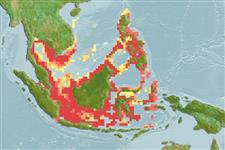>
Clupeiformes (Herrings) >
Dorosomatidae (Gizzard shads and sardinellas)
Etymology: Herklotsichthys: After Janus Adrian Herklots, Australian ichthyologist, 1820-1872.
Eponymy: Dr Geoffrey Alton Craig Herklots (1902–1986) was a British biologist, botanist and ornithologist at the University of Hong Kong (1928–1941). [...] (Ref. 128868), visit book page.
More on author: Bleeker.
Environment: milieu / climate zone / depth range / distribution range
Ecología
marino; salobre; rango de profundidad 0 - 50 m (Ref. 188). Tropical; 20°N - 9°S, 98°E - 129°E (Ref. 188)
Western Central Pacific: Gulf of Thailand, Philippines, and Indonesia.
Tamaño / Peso / Age
Maturity: Lm ? range ? - ? cm
Max length : 8.5 cm SL macho / no sexado; (Ref. 188); common length : 7.0 cm SL macho / no sexado; (Ref. 188)
Espinas dorsales (total) : 0; Radios blandos dorsales (total) : 13 - 21; Espinas anales: 0; Radios blandos anales: 12 - 23. Immediately distinguished from all other species of Herklotsichthys by the presence of two dark saddle-like blotches on the back, at the hind part of the dorsal fin base and a short distance behind this. Overlaps range of H. quadrimaculatus, which lacks the black saddles and has elongate wing-like scales underneath the normal paired pre-dorsal scales.
A schooling species found in coastal waters. Uncommon.
Life cycle and mating behavior
Madurez | Reproducción | Puesta | Huevos | Fecundidad | Larva
Whitehead, P.J.P., 1985. FAO Species Catalogue. Vol. 7. Clupeoid fishes of the world (suborder Clupeoidei). An annotated and illustrated catalogue of the herrings, sardines, pilchards, sprats, shads, anchovies and wolf-herrings. FAO Fish. Synop. 125(7/1):1-303. Rome: FAO. (Ref. 188)
IUCN Red List Status (Ref. 130435: Version 2024-2)
Threat to humans
Harmless
Human uses
Pesquerías: pesquerías de subsistencia
Herramientas
Special reports
Download XML
Fuentes de Internet
Estimates based on models
Preferred temperature (Ref.
123201): 28.1 - 29.1, mean 28.8 °C (based on 416 cells).
Phylogenetic diversity index (Ref.
82804): PD
50 = 0.5002 [Uniqueness, from 0.5 = low to 2.0 = high].
Bayesian length-weight: a=0.00871 (0.00415 - 0.01826), b=3.06 (2.89 - 3.23), in cm total length, based on LWR estimates for this (Sub)family-body shape (Ref.
93245).
Nivel trófico (Ref.
69278): 3.1 ±0.3 se; based on size and trophs of closest relatives
Resiliencia (Ref.
120179): Alto, población duplicada en un tiempo mínimo inferior a 15 meses (Preliminary K or Fecundity.).
Fishing Vulnerability (Ref.
59153): Low vulnerability (10 of 100).
Nutrients (Ref.
124155): Calcium = 432 [241, 922] mg/100g; Iron = 2.84 [1.70, 4.82] mg/100g; Protein = 18.9 [17.8, 19.9] %; Omega3 = 0.51 [0.26, 0.98] g/100g; Selenium = 37.8 [17.6, 79.0] μg/100g; VitaminA = 39.8 [16.7, 90.4] μg/100g; Zinc = 2.34 [1.61, 3.50] mg/100g (wet weight);
